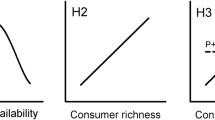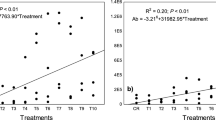Abstract
Diversity within distinct trophic groups is proposed to increase ecosystem functions such as the productivity of this group and the efficiency of resource use. This proposition has mainly been tested with plant communities, consumer assemblages, and multitrophic microbial assemblages. Very few studies tested how this diversity–productivity relationship varies under different environmental regimes such as disturbances. Coastal benthic assemblages are strongly affected by temporal instability of abiotic conditions. Therefore, we manipulated benthic ciliate species richness in three laboratory experiments with three diversity levels each and analyzed biomass production over time in the presence or absence of a single application of a disturbance (ultraviolet-B [UVB] radiation). In two out of three experiments, a clear positive relationship between diversity and productivity was found, and also the remaining experiment showed a small but nonsignificant effect of diversity. Disturbance significantly reduced the total ciliate biomass, but did not alter the relation between species richness and biomass production. Significant overyielding (i.e., higher production at high diversity) was observed, and additive partitioning indicated that this was caused by niche complementarity between ciliate species. Species-specific contribution to the total biomass varied idiosyncratically with species richness, disturbance, and composition of the community. We thus present evidence for a significant effect of consumer diversity on consumer biomass in a coastal ciliate assemblage, which remained consistent at different disturbance regimes.



Similar content being viewed by others
References
Balvanera, P., A. B. Pfisterer, N. Buchmann, J.-S. He, T. Nakashizuka, D. Raffaelli and B. Schmid. 2006. Quantifying the evidence for biodiversity effects on ecosystem functioning and services. Ecology Letters 9:1146–1156.
Berninger, U.-G. and S. S. Epstein. 1995. Vertical distribution of benthic ciliates in response to the oxygen concentration in an intertidal North Sea sediment. Aquatic Microbial Ecology 9:229–236.
Bruno, J. F. and M.I. O’Connor 2005. Cascading effects of predator diversity and omnivory in a marine food web. Ecology Letters 8:1048–1056.
Byrnes, J, J. J. Stachowicz, K. M. Hultgren et al. 2006. Predator diversity strengthens trophic cascades in kelp forests by modifying herbivore behaviour. Ecology Letters 9:61–71.
Byrnes, J. E., P. L. Reynolds and J. J. Stachowicz. 2007 Invasions and extinctions reshape coastal marine food webs. PLoS ONE 2:e295.
Cardinale, B. J., D. S. Srivastava, J. E. Duffy, et al. 2006. Effects of biodiversity on the functioning of trophic groups and ecosystems. Nature 443:989–992.
Claessen, D., A. M. de Roos and L. Persson 2004. Population dynamic theory of size-dependent cannibalism. Proceedings of the Royal Society of London B 271:333–340.
Dietrich, D. and H. Arndt 2000. Biomass partitioning of benthic microbes in a Baltic inlet: Relationships between bacteria, algae, heterotrophic flagellates and ciliates. Marine Biology 136:309–322.
Duffy, J. E., K. S. Macdonald, J. M. Rhode, and J. D. Parker. 2001. Grazer diversity, functional redundancy, and productivity in seagrass beds: An experimental test. Ecology 82:2417–2434.
Duffy, J. E., J. P. Richardson, and E. A. Canuel. 2003. Grazer diversity effects on ecosystem functioning in seagrass beds. Ecology Letters 6:637–645.
Duffy, J.E., J.P. Richardson and K.E. France 2005. Ecosystem consequences of diversity depend on food chain length in estuarine vegetation. Ecology Letters 8:301–309.
Epstein S. S. 1997. Microbial food webs in marine sediments. I. Trophic interactions and grazing rates in two tidal flat communities. Microbial Ecology 34:188–198.
Finke, D.L. and R. F. Denno 2005. Predator diversity and the functioning of ecosystems: The role of intraguild predation in dampening trophic cascades. Ecology Letters 8:1299–1306.
Gamfeldt, L., H. Hillebrand and P. R. Jonsson 2005. Species richness changes across two trophic levels simultaneously affect prey and consumer biomass. Ecology Letters 8:696–703.
Hooper, D. U., F. S. Chapin III, J. J. Ewel, et al. 2005. Effects of biodiversity on ecosystem functioning: a consensus of current knowledge. Ecological Monographs 75:3–35.
Huston, M. A. 1997. Hidden treatments in ecological experiments: Re-evaluating the ecosystem function of biodiversity. Oecologia 110:449–460.
Kinzig, A. P., S. W. Pacala and D. Tilman 2002. The Functional Consequences of Biodiversity. Princeton: Princeton University Press.
Lass, H. U. and L. Magaard. 1995. Wasserstandsschwankungen und Seegang. In Meereskunde der Ostsee, ed. G. Rheinheimer 68–74. Berlin: Springer Verlag.
Loreau, M. 2000. Biodiversity and ecosystem functioning: Recent theoretical advances. Oikos 91:3–17.
Loreau, M. and A. Hector. 2001. Partitioning selection and complementarity in biodiversity experiments. Nature 412:72–76.
Loreau, M., S. Naeem, P. Inchausti, J. Bengtsson, J. P. Grime, A. Hector, D. U. Hooper, M. A. Huston, D. Raffaelli, B. Schmid, D. Tilman, and D. A. Wardle. 2001. Biodiversity and ecosystem functioning: Current knowledge and future challenges. Science 294:804–808.
Loreau M., A. Downing, M. Emmerson et al. 2002. A new look at the relationship between diversity and stability. In Biodiversity and ecosystem functioning, ed. P. Inchausti, 79–91. Oxford, U.K.: Oxford University Press
Mikola, J. and H. Setälä. 1998. Relating species diversity to ecosystem functioning: Mechanistic backgrounds and experiental approach with a decomposer food web. Oikos 83:180–194.
Naeem, S. and S. Li. 1998. Consumer species richness and autotrophic biomass. Ecology 79:2603–2615.
Pacala, S. W. and D. Tilman. 2001. The transition from sampling to complementarity. In The functional consequences of biodiversity, D. Tilman, ed. 151–166. Princ0eton: Princeton University Press
Petchey, O. L., P. T. McPhearson, T. M. Casey, and P. J. Morin. 1999. Environmental warming alters food-web structure and ecosystem function. Nature 402:69–72.
Petchey, O. L., A. L. Downing, G. G. Mittelbach et al. 2004. Species loss and the structure and functioning of multitrophic aquatic systems. Oikos 104:467–478.
Pfisterer, A. B. and B. Schmid. 2002. Diversity-dependent production can decrease the stability of ecosystem functioning. Nature 416:84–86.
Sanders, R. W., A. L. Macaluso, T. J. Sardina, and D. L. Mitchell. 2005. Photoreactivation in two freshwater ciliates: Differential responses to variations in UV-B flux and temperature. Aquatic Microbial Ecology 40:283–292.
Snyder,W. E., G. B. Snyder, D. L. Finke and C. S. Straub 2006. Predator biodiversity strengthens herbivore suppression. Ecology Letters 9:789–796.
Sommeruga, R. and G. J. Buma 2000. UV-induced cell damage is species-specific among aquatic phagotrophic protists. Journal of Eukaryotic Microbiology 47:450–455.
Steiner, C. F. , T. L. Darcy-Hall, N. J. Dorn et al. 2005. The influence of consumer diversity and indirect facilitation on trophic level biomass and stability. Oikos 110:556–566.
Stoecker, D. K. and D. J. Gifford. 1994. Preservation of marine planktonic ciliates: Losses and cell shrinkage during fixation. Marine Ecology Progress Series 110:293–299.
Straub, C. S. and W. E. Snyder 2006. Species identity dominates the relationship between predator biodiversity and herbivore suppression. Ecology 87:277–282.
Symstad, A. J., D. Tilman, J. Willson, and J. M. H. Knops. 1998. Species loss and ecosystem functioning: Effects of species identity and community composition. Oikos 81:389–397.
Tilman, D., J. Knops, D. Wedin, P. Reich, M. Ritchie, and E. Siemann. 1997. The influence of functional diversity and composition on ecosystem processes. Science 277:1300–1301.
United Nations Environmental Program (1998). Environmental effects of ozone depletion: 1998 assessment.
Utermöhl, H. 1958. Zur Vervollkommnung der qualitativen Phytoplanktonmethodik. Mitteilungen der Internationalen Vereinigung für Limnologie 9:1–38.
Wickham, S. and M. Carstens. 1998. Effects of ultraviolet-B radiation on two arctic microbial food webs. Aquatic Microbial Ecology 16:163–171.
Wickham, S., A. Gieseke, and U.-G. Berninger. 2000. Benthic ciliate identification and enumeration: An improved methodology and its application. Aquatic Microbial Ecology 22:79–91.
Worm, B. and J. E. Duffy. 2003. Biodiversity, productivity and stability in real food webs. Trends in Ecology and Evolution 18:628–632.
Acknowledgments
We thank S. Ballmeier, R. Karez, and U. Sommer at the Institute for Marine Sciences in Kiel for helpful discussions, T. Reusch for statistical advice, and the DFG (Deutsche Forschungsgemeinschaft, BE 2279/2) for their financial support.
Author information
Authors and Affiliations
Corresponding author
Rights and permissions
About this article
Cite this article
Moorthi, S.D., Hillebrand, H., Wahl, M. et al. Consumer Diversity Enhances Secondary Production by Complementarity Effects in Experimental Ciliate Assemblages. Estuaries and Coasts: J CERF 31, 152–162 (2008). https://doi.org/10.1007/s12237-007-9015-6
Received:
Revised:
Accepted:
Published:
Issue Date:
DOI: https://doi.org/10.1007/s12237-007-9015-6




